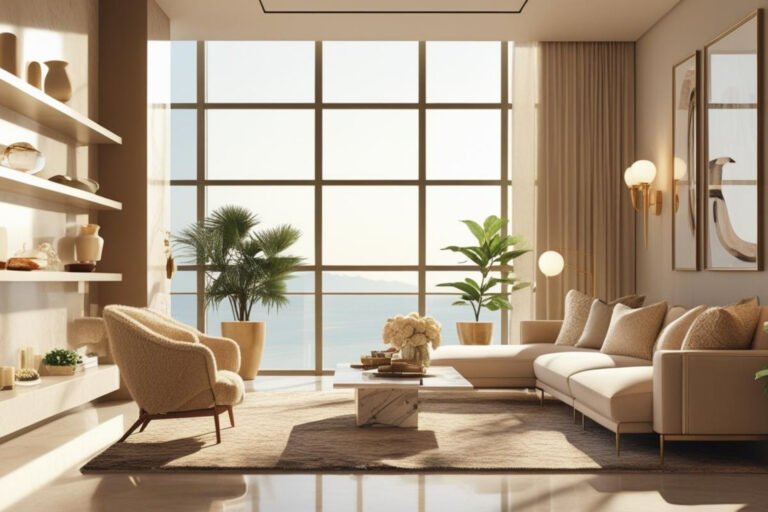25 Small Living Room Ideas to Maximize Space and Comfort
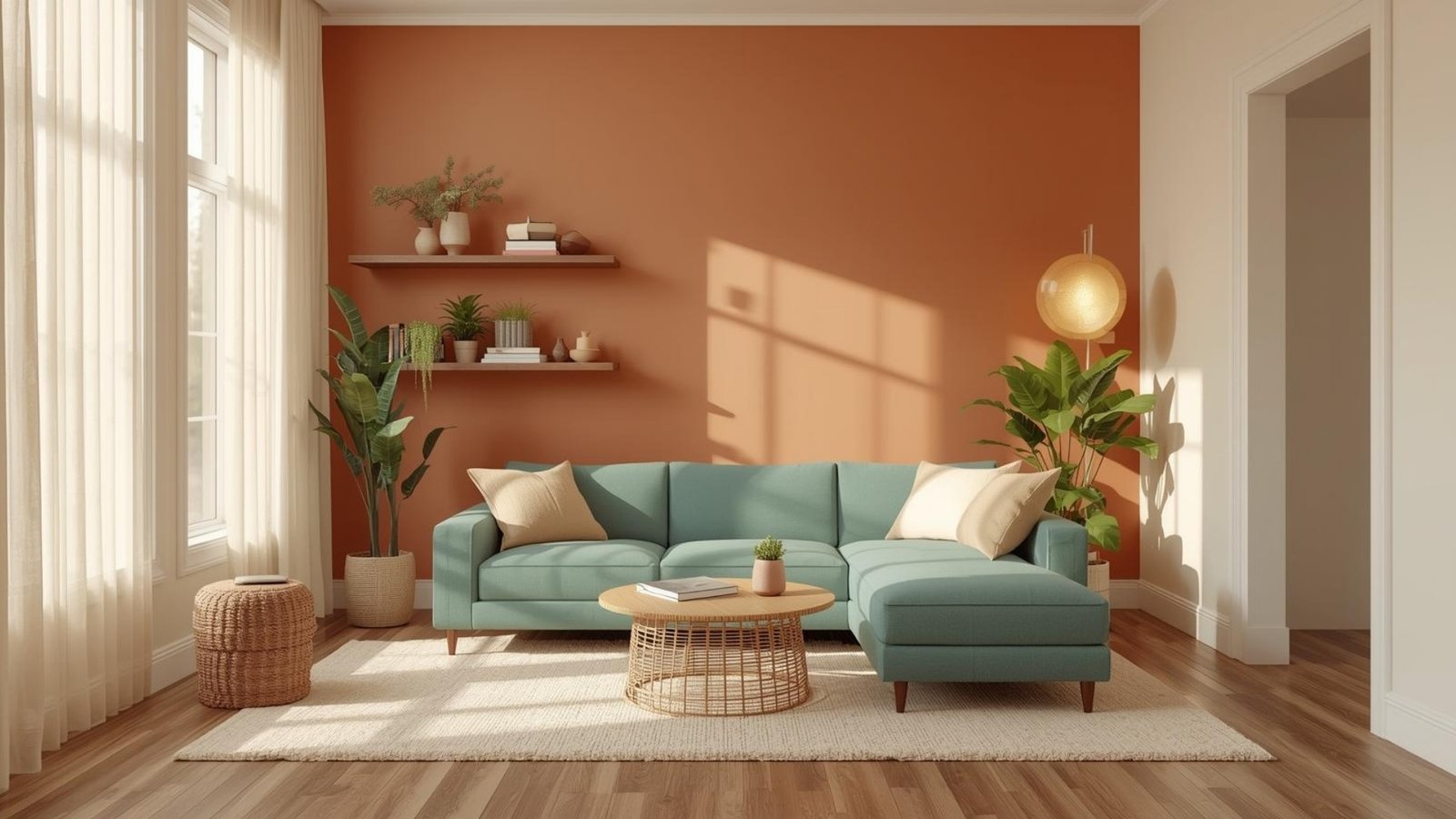
Introduction
Designing a small living room may seem tricky, but with the right approach, it can become the coziest and most stylish spot in your home. By using smart layouts, clever storage solutions, and thoughtful décor choices, you can transform even the tiniest living room into a functional and inviting space. Small living room ideas allow you to maximize space while ensuring comfort and elegance.
The key lies in balance—balancing comfort with openness, style with functionality, and storage with aesthetics. Whether you live in an apartment, studio, or a compact home, there are countless ways to make your living room feel airy, organized, and beautiful. From furniture choices to lighting and color palettes, every detail can help open up the spaceand add charm.
1. Use Light Colors to Open Up the Space
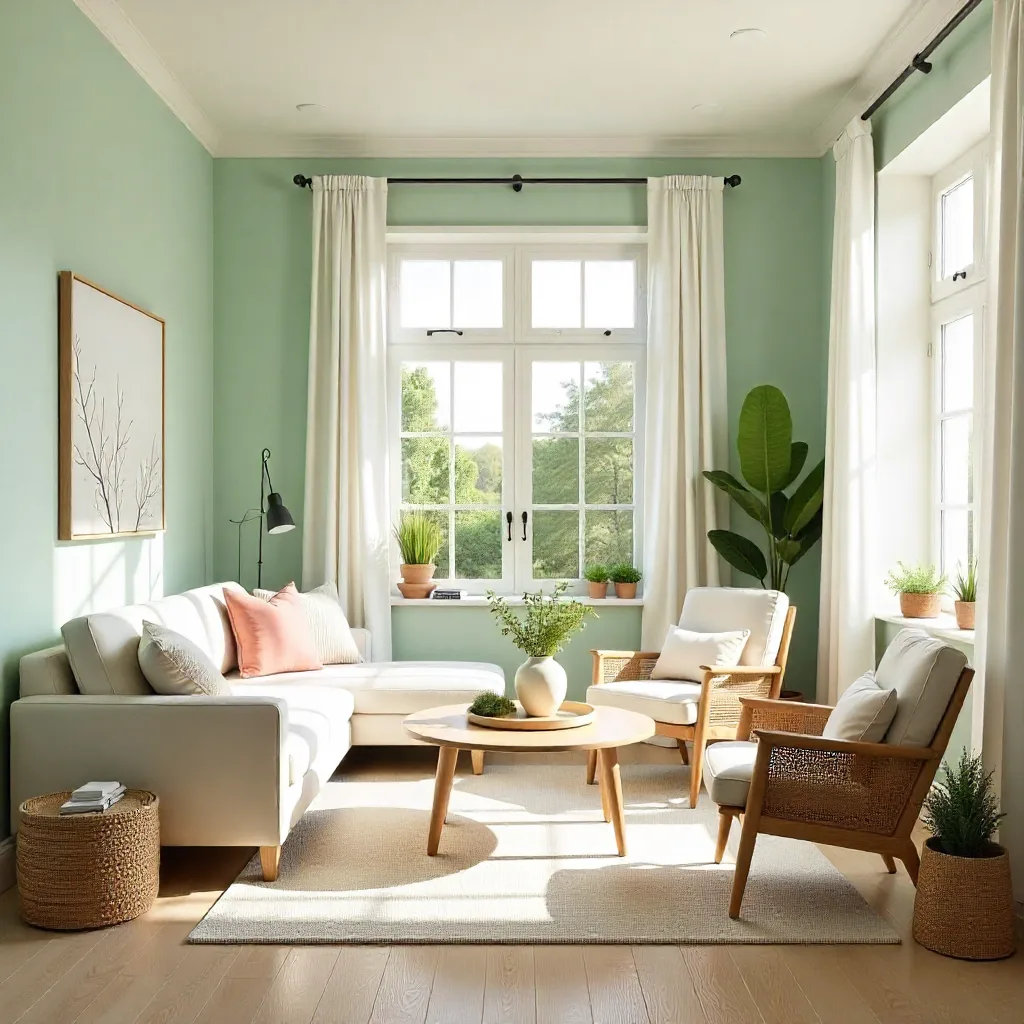
Light colors like white, beige, and pale gray bring instant brightness to a small living room. These shades reflect sunlight, making walls seem farther apart and ceilings appear higher. When paired with soft pastels or natural textures, light hues create a balanced palette that feels fresh, airy, and inviting. Incorporating woven rugs, linen curtains, and wooden accents prevents the room from feeling flat, adding warmth without heaviness.
From a practical perspective, light walls and furnishings offer versatility for changing décor with the seasons. A neutral base lets you update your style with small accessories such as throw pillows, blankets, or wall art—without having to redo the entire room. Light colors also help conceal everyday dust or minor marks, keeping your space looking clean and open with less effort.
2. Opt for Multi-Functional Furniture
Small living rooms demand furniture that earns its place, which makes multi-functional pieces a clever solution. A sofa bed offers both seating and sleeping space, while a storage ottoman doubles as a coffee table and a place to tuck away blankets or books. Nesting tables are another excellent option, providing flexibility when entertaining but tucking neatly aside when not in use. These pieces combine modern design with smart functionality, ensuring style without clutter.
On the functional side, multi-purpose furniture helps maximize limited floor space and reduces the need for excess pieces. This creates smoother pathways for movement and keeps the room looking tidy. It also helps you adapt your living room for different occasions—whether it’s hosting friends, lounging with family, or creating a quiet reading nook. Every inch matters, and furniture that does double duty ensures you’re getting the most out of your space.
3. Embrace Vertical Space with Tall Shelving
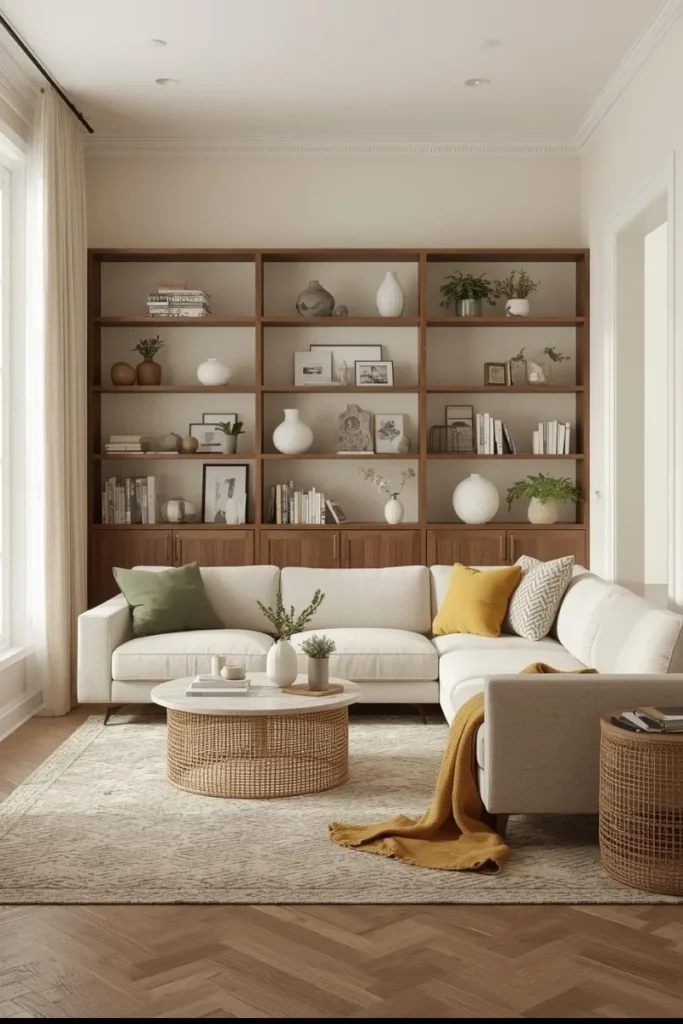
When horizontal space is scarce, vertical solutions can completely change the feel of a room. Tall shelving units or ladder-style bookcases draw the eye upward, emphasizing ceiling height and adding visual drama. Styling the shelves with plants, framed photos, and decorative accents creates personality without overwhelming the room. Floating shelves are another option, freeing up floor space while still offering storage and display opportunities.
Beyond design, vertical storage maximizes capacity in small spaces. It keeps essentials organized, from books and electronics to baskets of everyday items, while ensuring the floor stays uncluttered. A well-styled shelving unit combines beauty and practicality, serving as both storage and a feature wall. By looking upward instead of outward, you’ll discover hidden potential in your living room.
4. Choose a Statement Rug to Define the Room
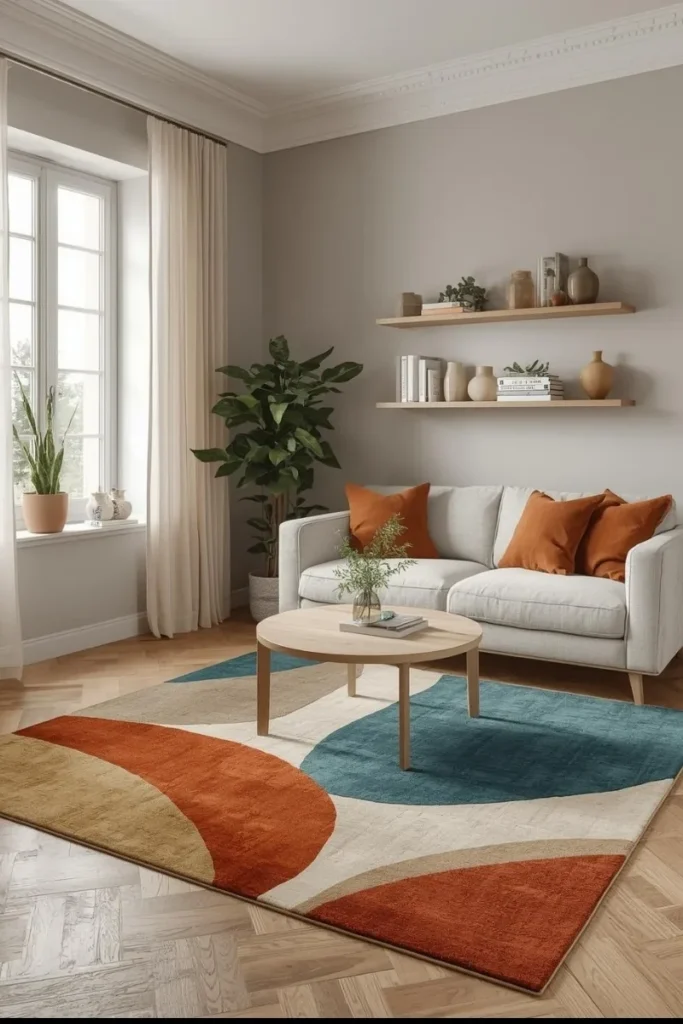
A statement rug adds character, anchors furniture, and visually defines your living space. Whether bold and patterned or subtly textured, rugs help guide the eye and create a sense of cohesion. In small rooms, they separate zones—like seating areas or reading corners—without the need for extra furniture. Layering rugs in complementary tones also adds depth and coziness, enhancing the overall style.
From a practical standpoint, rugs protect floors and make the space more comfortable underfoot. They also absorb sound, reducing echo in compact rooms with hard surfaces. Choosing the right rug size—large enough to sit under at least the front legs of your sofa and chairs—ensures balance, preventing the space from feeling disjointed. The right rug adds both warmth and structure, turning a small living room into a polished and welcoming retreat.
5. Maximize Natural Light with Sheer Curtains
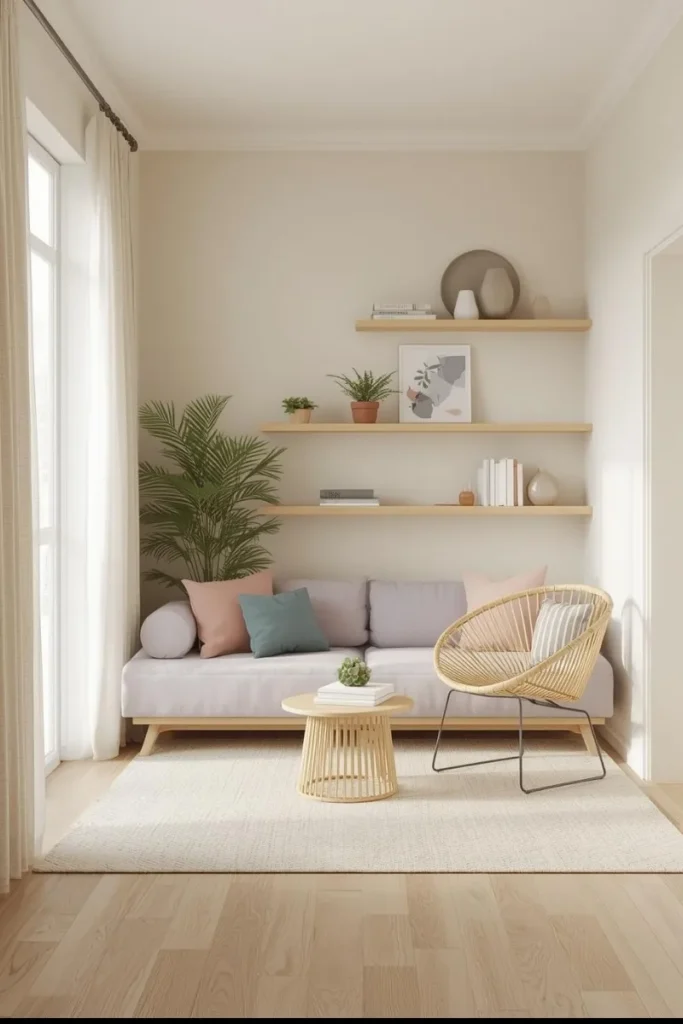
Natural light is one of the most powerful ways to make a small living room feel bigger. Sheer or light linen curtains allow sunlight to stream through while still offering privacy. Floor-to-ceiling drapery creates the illusion of taller walls, making the room appear more spacious and elegant. Choosing neutral or soft shades ensures the curtains blend seamlessly with the décor, keeping the room cohesive and airy.
Functionally, sheer curtains are lightweight, low-maintenance, and easy to layer with blackout blinds if needed. They filter light beautifully throughout the day, enhancing mood and highlighting textures and colors in your living room. By letting natural light in, you reduce the need for artificial lighting during the day and create a space that feels both open and welcoming, regardless of its size.
6. Go Minimal with a Sleek Sofa
In small living rooms, the sofa often takes up the most space, so choosing the right design is essential. Sleek, low-profile sofas with clean lines keep the room feeling light and uncluttered, unlike bulky or oversized designs that overwhelm the layout. Neutral upholstery in shades of beige, light gray, or ivory blends seamlessly into the background, while textured throw pillows or a soft blanket add personality without crowding the space. Minimal sofas help establish a calm and modern look, making the living room appear larger than it is.
On the functional side, compact sofas leave more room for circulation and other furniture, allowing you to create a balanced seating arrangement. Many sleek designs now come with hidden storage or modular options, making them perfect for adapting to small spaces. Their understated shape also ensures long-term flexibility, so you can easily restyle your living room without needing to replace the main seating. A slim, modern sofa is not only visually appealing but also practical, giving your living room a polished yet comfortable foundation.
7. Use Mirrors to Reflect Light and Expand Space
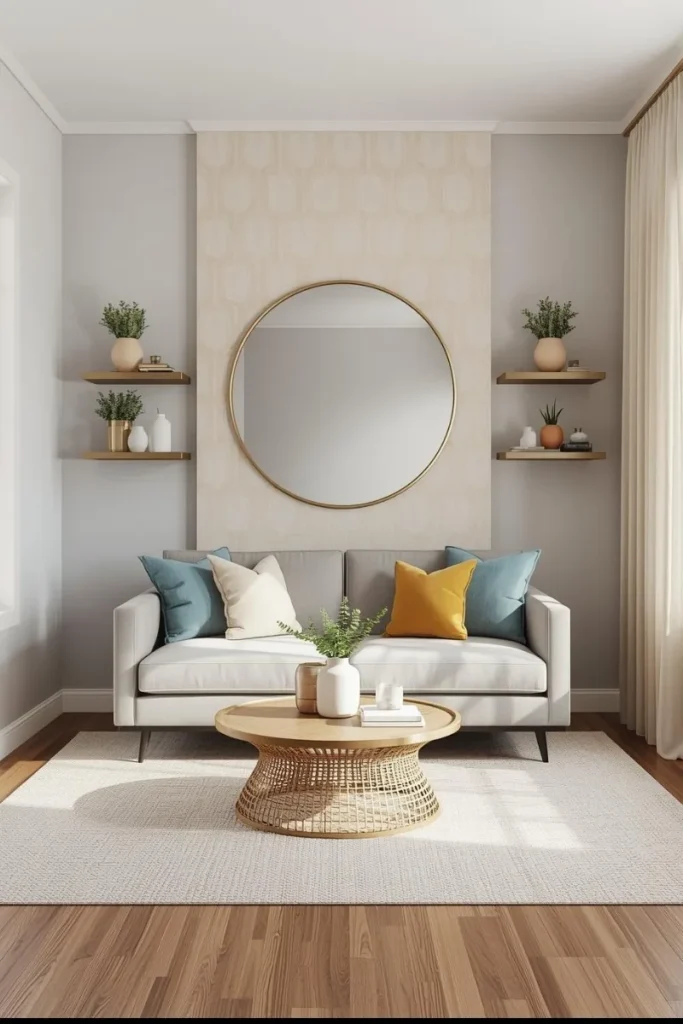
Mirrors are one of the most effective tools for visually enlarging a small living room. A large mirror placed opposite a window bounces natural light around the room, making it appear brighter and more spacious. Decorative mirrors, whether round, rectangular, or uniquely framed, double as art while serving a functional role. By carefully placing them behind a sofa or above a console, you can create a focal point that enhances both style and dimension.
From a functional perspective, mirrors are low-maintenance, versatile, and budget-friendly design elements. They work with nearly every décor style—from sleek modern to cozy farmhouse—while requiring minimal upkeep. In compact homes, mirrors can even replace artwork for a cleaner, more minimal look. When paired with thoughtful lighting, they amplify brightness and open up the room, turning small spaces into airy, welcoming environments.
8. Install Floating Shelves for Smart Storage
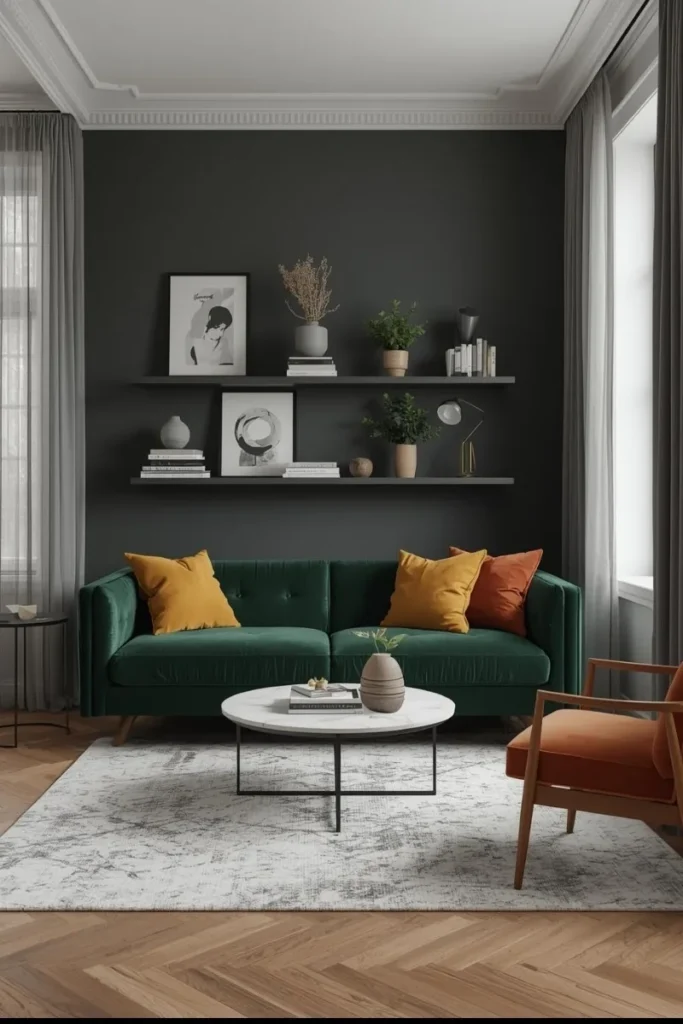
Floating shelves are a stylish solution that saves floor space while offering ample room for display. Installed above sofas, in corners, or along unused walls, they create vertical interest and prevent the room from feeling boxed in by heavy furniture. Styling them with books, plants, or small art pieces adds warmth and character, while the absence of bulky supports keeps the look light and contemporary. Floating shelves let you personalize your small living room without overwhelming the limited square footage.
Practically speaking, floating shelves are space-saving heroes. They free up the floor for essential seating or movement, while still giving you room to store or showcase your belongings. They can be customized in length, depth, and finish, making them adaptable to any interior style. Easy to install and maintain, they combine beauty with practicality, helping you maximize storage and keep your living room organized and functional.
9. Add Personality with Bold Accent Chairs
A bold accent chair can be a game-changer in a small living room, offering both function and flair. Chairs with unique fabrics, eye-catching colors, or sculptural silhouettes become instant focal points, elevating the room’s design. Slim-legged chairs, cane-backed designs, or velvet-upholstered options add style without overwhelming the layout. Placing a chair at an angle breaks up the boxy feel of a compact space and introduces natural flow into the room.
From a practical angle, accent chairs are versatile and can easily be moved around depending on your needs. They provide extra seating without taking up as much room as a second sofa, making them ideal for entertaining. Because they are usually smaller in scale, they also allow for experimentation with patterns, textures, or colors you might hesitate to use on larger furniture. Accent chairs enhance both the comfort and flexibility of your living room while giving it unique character.
10. Create Zones with Furniture Layout
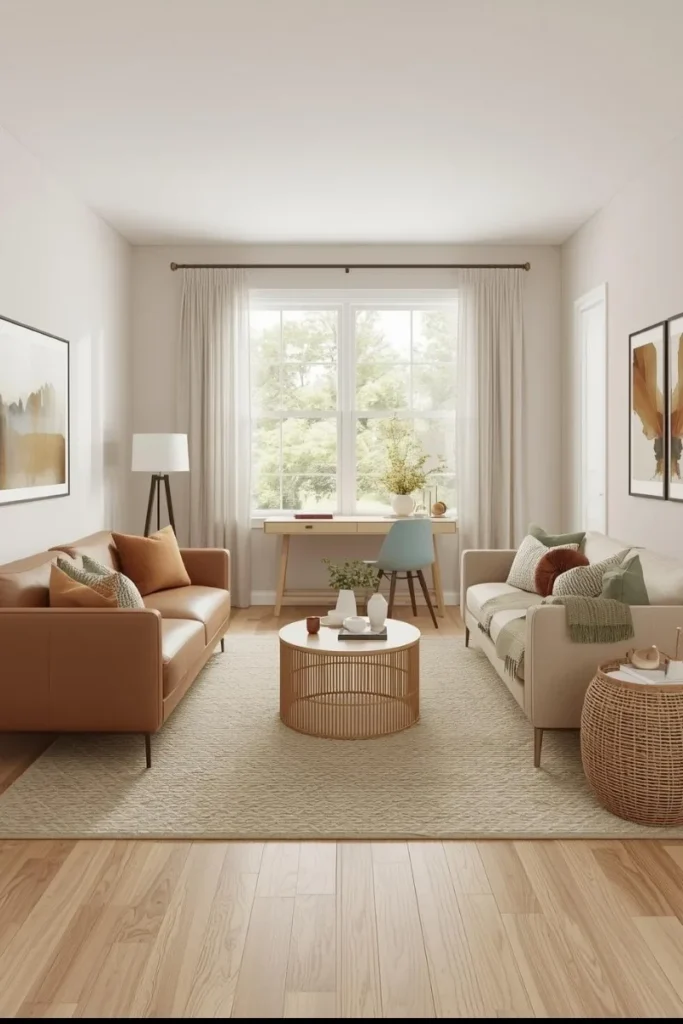
Even in small living rooms, zoning the space helps create a sense of order and purpose. Strategic placement of rugs, furniture, and lighting can subtly define areas—like a conversation corner, reading nook, or workspace—without using physical dividers. By floating furniture slightly away from the walls and arranging seating around a central coffee table, you create an intentional flow that feels both functional and inviting. These layout tricks keep the space open while ensuring every corner serves a role.
On the functional side, zoning prevents clutter and makes movement easier, which is crucial in compact rooms. It ensures that the living room supports multiple activities—like relaxing, entertaining, or working—without feeling chaotic. Clear zones also help guide the eye and make the room appear more thoughtfully designed. With smart zoning, your living room not only looks better but also works harder, making it a true multi-purpose hub.
11. Layer Rugs for Depth and Warmth
In small living rooms, rugs play a big role in tying the space together. Layering rugs—such as placing a patterned smaller rug over a larger neutral one—adds depth and character without overwhelming the layout. This trick creates texture, warmth, and visual zones that make the room feel more dynamic. Using natural fibers like jute as a base and layering a colorful or patterned rug on top blends comfort with personality, giving the floor a cozy and stylish touch.
Functionally, layered rugs help define seating areas, protect flooring, and make small spaces feel intentional rather than crowded. They also allow flexibility—swap out the top rug seasonally for a refreshed look without major changes. Layering works especially well in apartments or rentals where flooring can’t be updated, instantly elevating the space. This design move balances practicality with creativity, making the living room both functional and inviting.
12. Use Light Colors on Walls and Ceilings
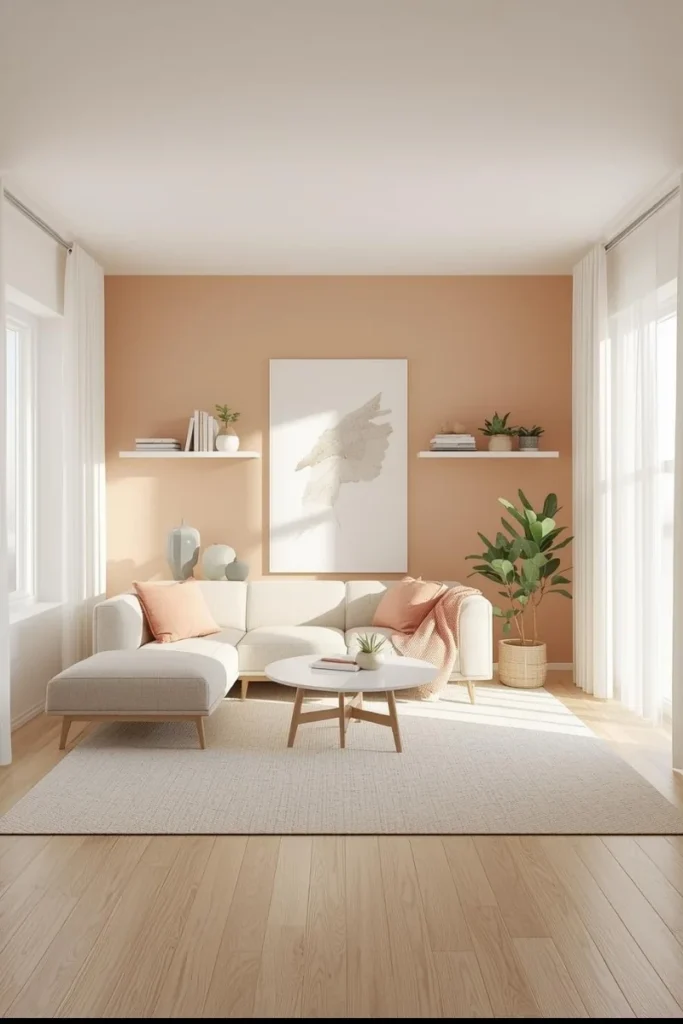
Light-colored walls are a timeless trick for expanding the feel of a compact living room. Soft whites, airy creams, and pale grays reflect natural light, giving the room a bright, open feel. Pairing these shades with subtle accents—like muted blues or sage greens—adds character while maintaining an uncluttered atmosphere. A light ceiling color further opens the vertical dimension, making the entire room feel taller and more breathable.
Beyond aesthetics, light walls are versatile, acting as a backdrop that lets furniture and décor stand out. They’re also easier to restyle since they complement any color palette. If you enjoy seasonal updates, you can easily change pillows, throws, or art without worrying about clashing. This functional adaptability ensures your small living room always looks fresh, while maintaining a clean, airy foundation.
13. Add Greenery with Potted Plants
Plants breathe life into a small living room, adding freshness, texture, and natural color. A tall fiddle-leaf fig in the corner, a snake plant beside the sofa, or small succulents on floating shelves bring softness to sharp lines and create a calming environment. Greenery enhances visual depth, breaking up neutral tones and making the room feel more balanced and inviting.
Practically, plants do more than beautify—they improve air quality and contribute to a healthier indoor environment. Compact plants require little maintenance and can thrive in smaller containers, making them perfect for limited spaces. Hanging planters or wall-mounted options save floor space while still providing greenery. Plants are one of the easiest, most cost-effective ways to make a small living room feel vibrant and alive.
14. Multi-Functional Coffee Tables
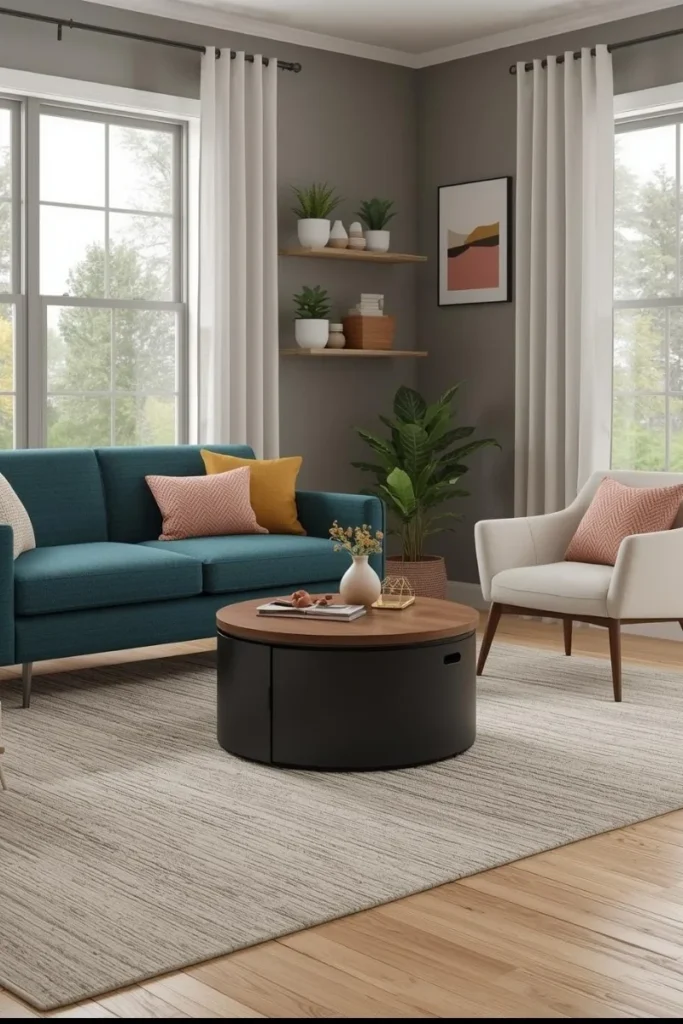
Coffee tables in small living rooms should work harder than just holding drinks. Choosing designs with hidden storage, nesting sections, or adjustable heights makes them incredibly functional. For example, a table with lift-up tops doubles as a work desk or dining surface, while storage drawers keep magazines and remotes neatly tucked away. Compact round designs also allow for easier movement around the seating area.
Functionally, these tables maximize limited square footage by reducing clutter and eliminating the need for extra storage furniture. They also adapt to changing needs—whether it’s hosting guests, working from home, or enjoying casual meals. A stylish coffee table becomes the centerpiece of the living room while quietly serving multiple purposes. This balance of form and function makes them an essential choice for small spaces.
15. Highlight the Room with Statement Lighting
Lighting can transform the mood and feel of a small living room instantly. A statement chandelier, modern pendant, or sculptural floor lamp not only illuminates the space but also serves as a design centerpiece. Layering light with a mix of ceiling fixtures, table lamps, and wall sconces ensures both functionality and ambiance, making the room glow warmly. Statement lighting draws the eye upward, creating the illusion of height in compact areas.
From a functional perspective, lighting zones help define different activities, like reading, entertaining, or relaxing. Adjustable fixtures allow you to control brightness, ensuring flexibility throughout the day. Good lighting also highlights textures, colors, and furniture details, elevating the overall look of the room. In small living rooms, smart lighting choices can create atmosphere, expand the sense of space, and enhance comfort all at once.
16. Wall-Mounted Shelving for Vertical Storage
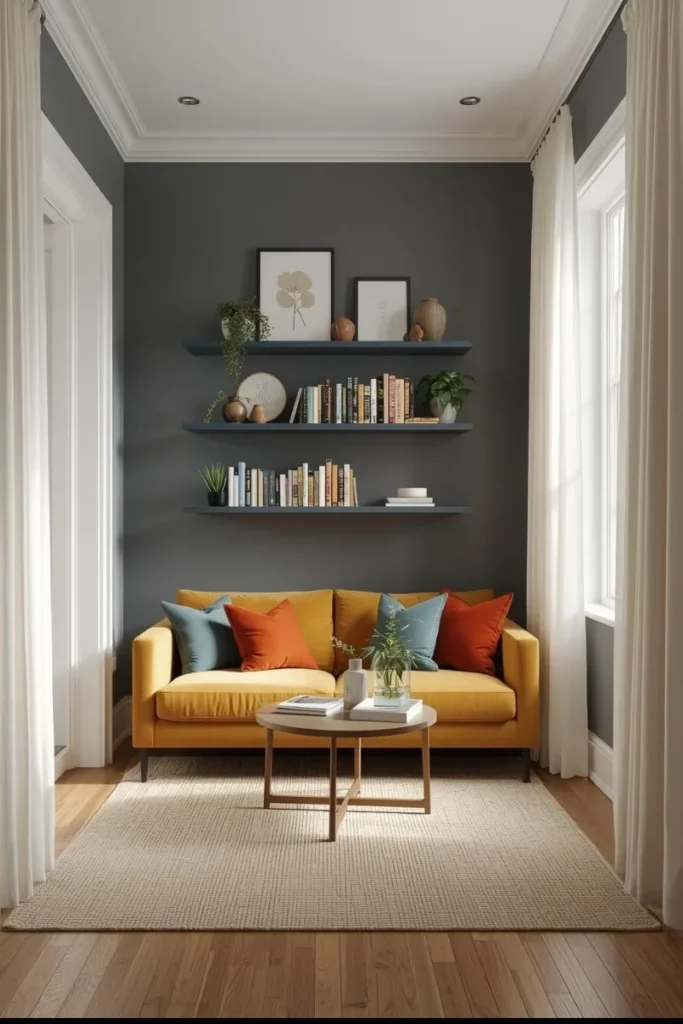
When floor space is limited, walls become your best friend. Wall-mounted shelving maximizes vertical space while keeping the room uncluttered. Slim floating shelves can display books, plants, or decorative accents without overwhelming the room. By placing shelves higher up, you also draw the eye upward, making the ceiling feel taller and the space more expansive. This approach keeps essentials organized while leaving valuable floor space free for seating or movement.
Functionally, wall shelving is highly adaptable. Open shelves make everyday items easy to grab, while closed cabinets on the wall hide clutter. Adding built-in lighting beneath shelves further enhances the display, giving the room a soft glow. For renters, removable options like modular shelving work perfectly without permanent installation. This solution is both practical and stylish, balancing functionality with clean, modern aesthetics.
17. Choose Slimline Furniture Designs
Bulky furniture can easily overwhelm a small living room. Slimline sofas, armchairs with narrow arms, and sleek side tables maintain comfort while saving space. Furniture with thin legs creates visual openness, allowing light to pass underneath and giving the illusion of a larger area. Opting for pieces with minimalist designs ensures the room looks airy and uncluttered, without sacrificing seating or style.
From a practical perspective, slimline furniture makes it easier to rearrange the layout or adapt to new needs. It also provides flexibility—leaving room for extra accents like plants, lamps, or storage ottomans. The overall result is a balanced, breathable living room where every item feels intentional and proportionate to the space. This choice combines modern elegance with functionality, perfect for small homes.
18. Create a Gallery Wall of Art
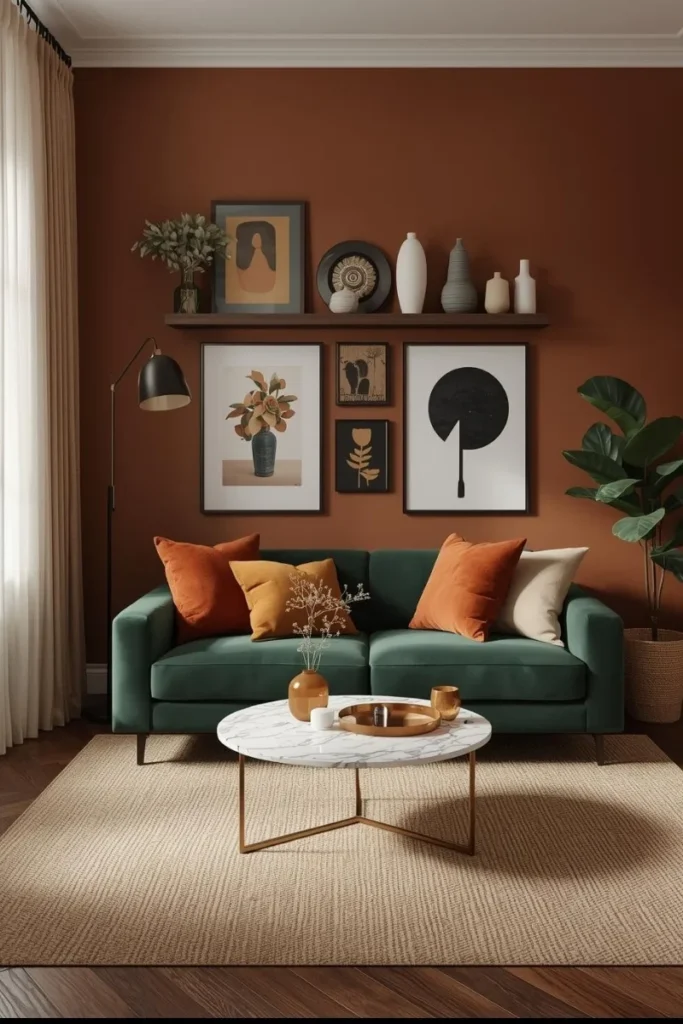
A gallery wall is a striking way to add personality without taking up precious floor space. Whether you choose family photos, abstract prints, or a mix of frames, this arrangement creates a focal point that transforms plain walls into works of art. Positioning frames in a tight cluster or structured grid maximizes impact without feeling chaotic. The result is a stylish statement that makes your small living room feel curated and unique.
Functionally, a gallery wall allows you to tell a story through your décor while avoiding cluttered shelves or extra furniture. Swapping out prints is easy and affordable, letting you refresh the room with new color palettes or seasonal themes. With thoughtful arrangement, even small frames can create depth and visual interest, turning a compact living space into an inspiring, art-filled retreat.
19. Add Texture with Throws and Cushions
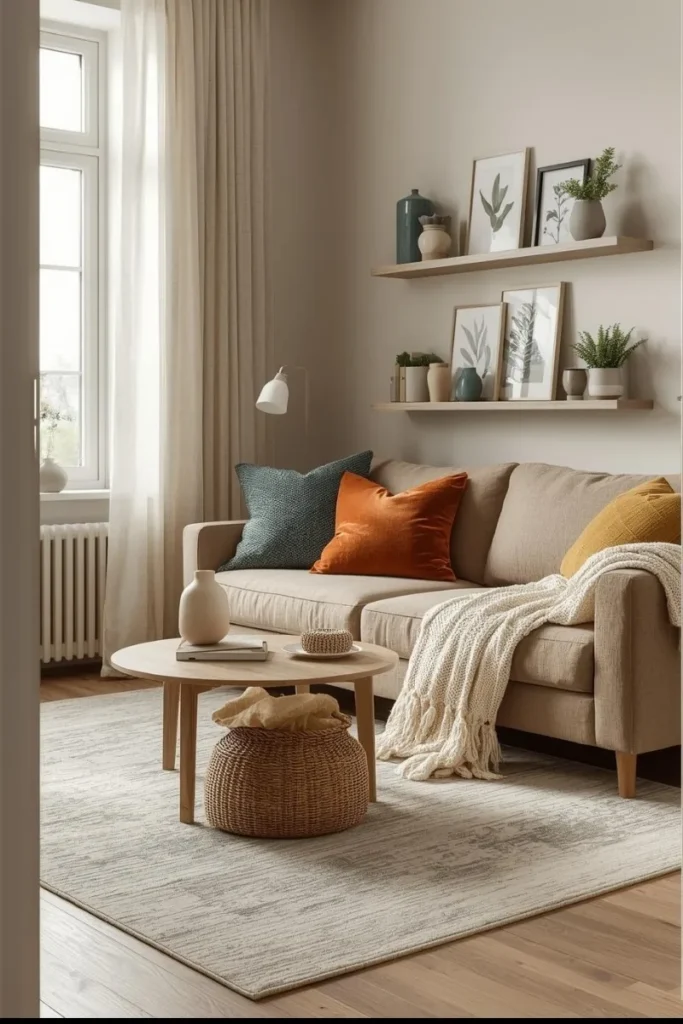
In small living rooms, soft furnishings can dramatically influence comfort and style. Layering throws and cushions in different textures—like chunky knits, linen, or velvet—brings warmth and depth to the seating area. A neutral sofa instantly feels more inviting when styled with patterned cushions or a draped throw blanket. This mix of textures adds coziness and visual richness, preventing the space from feeling flat.
On a functional level, throws and cushions are easy to update, making them a budget-friendly way to refresh the room. They also allow for seasonal changes—light cotton in summer, heavier knits in winter—ensuring comfort year-round. This adaptability makes soft furnishings a practical design tool, elevating the space without needing major updates. In compact rooms, small details like these can make a big difference in both comfort and atmosphere.
20. Incorporate Hidden Storage Solutions
Storage is one of the biggest challenges in small living rooms, but hidden solutions keep clutter at bay. Ottomans with lift-up tops, sofas with under-seat compartments, or benches with built-in drawers provide discreet storage without taking up extra space. These designs allow you to tuck away blankets, remote controls, or children’s toys, maintaining a clean and organized living environment.
Practically, hidden storage ensures the room feels calm and uncluttered, making it more enjoyable for daily use. It also reduces the need for extra furniture, allowing you to keep the layout open and flexible. Stylish storage solutions merge seamlessly with the design, ensuring practicality doesn’t compromise aesthetics. With hidden storage, your small living room stays both functional and visually pleasing.
21. Use Multipurpose Coffee Tables
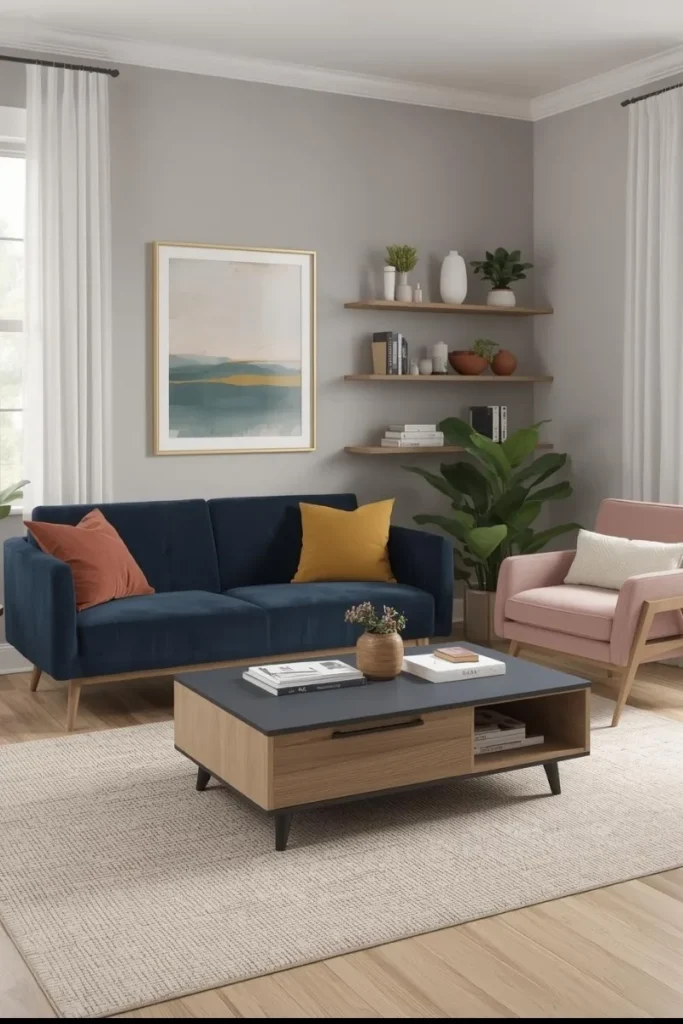
A coffee table is often the centerpiece of a living room, but in a small space, it needs to work harder. Choosing a multipurpose design—like one with hidden storage or a lift-top surface—adds both functionality and style. These tables can serve as storage for books and remotes, while also transforming into a work desk or dining surface when needed. The versatility ensures that your room adapts to different daily activities without feeling cluttered.
From a practical perspective, a multipurpose coffee table reduces the need for extra furniture, keeping the space open and flexible. The hidden compartments also help keep the living room tidy, giving everything a place while maintaining a sleek aesthetic. This smart design choice merges beauty with everyday usability, making it ideal for compact living environments where every square foot matters.
22. Choose Neutral Base Colors
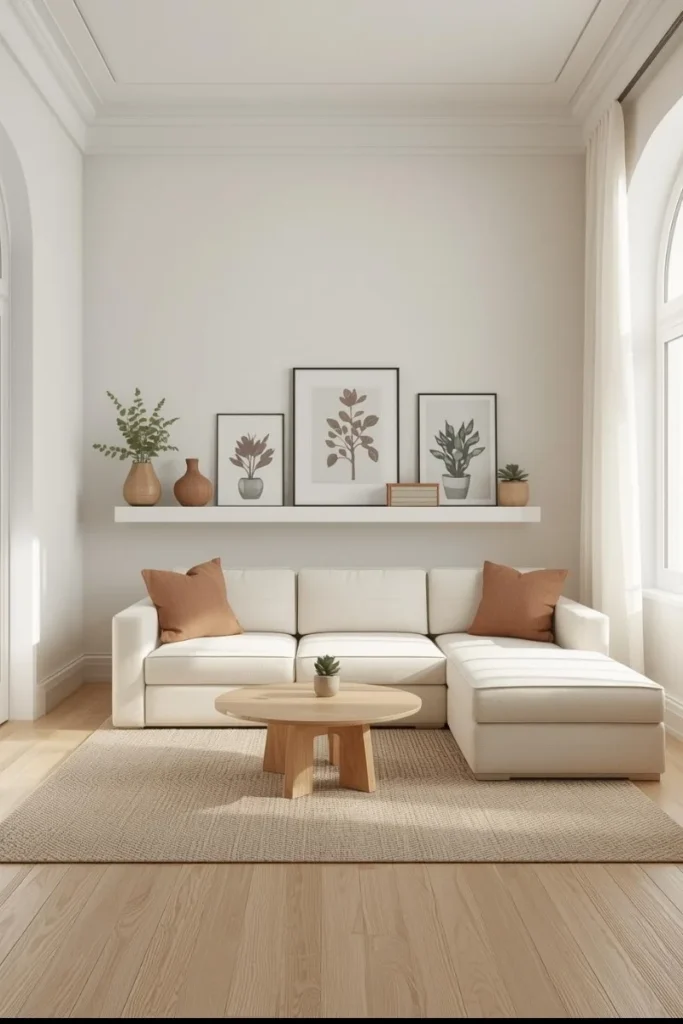
A neutral color palette—think whites, creams, soft grays, or beige—creates an open and airy feel in small living rooms. These tones reflect light, making walls appear farther apart and ceilings feel higher. By keeping the base palette calm, you create a canvas where textures, patterns, or accent colors can shine without overwhelming the space. The result is a timeless, soothing environment that feels larger and more inviting.
Functionally, neutral colors make it easier to redecorate or refresh your style without major renovations. Adding seasonal accents like colorful cushions or rugs becomes effortless when the foundation is versatile. Neutral walls and furniture also highlight natural light, enhancing brightness throughout the day. This approach balances flexibility with elegance, giving your small living room enduring appeal.
23. Add Mirrors to Expand the Room
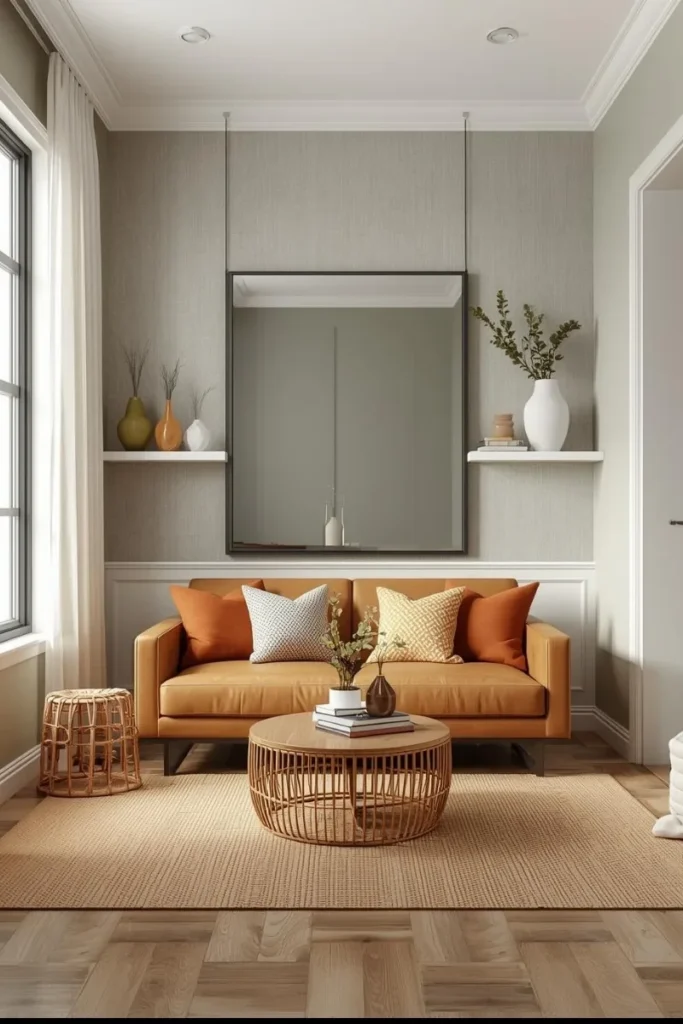
Mirrors are a classic design trick for making small spaces appear larger. A large wall mirror or a series of smaller decorative mirrors reflect light, creating depth and doubling the visual size of the room. Placing a mirror opposite a window is especially effective, as it brings more natural brightness into the room while visually extending the outdoor view.
Practically, mirrors also add style by acting as decorative elements in their own right. Whether you prefer minimalist frames, ornate designs, or sleek frameless styles, mirrors adapt to any décor theme. They’re low-maintenance, versatile, and instantly impactful, making them one of the easiest ways to elevate a small living room. With the right placement, a mirror transforms compactness into spacious charm.
24. Use Rugs to Define Zones
In open-plan or multi-functional living rooms, rugs help create defined zones without needing walls or partitions. A rug under the sofa and coffee table anchors the seating area, while a different rug might separate a small workspace or reading nook. This layering of zones brings structure to the layout, making the room feel intentional and organized.
On a functional level, rugs also add comfort, warmth, and texture underfoot. They soften hardwood or tile floors, making the space more welcoming. Choosing lighter tones or subtle patterns ensures the rug doesn’t overwhelm the room, while geometric designs can add modern flair. In small spaces, a thoughtfully placed rug balances practicality with aesthetics, tying the room together beautifully.
25.Install Compact Accent Chairs
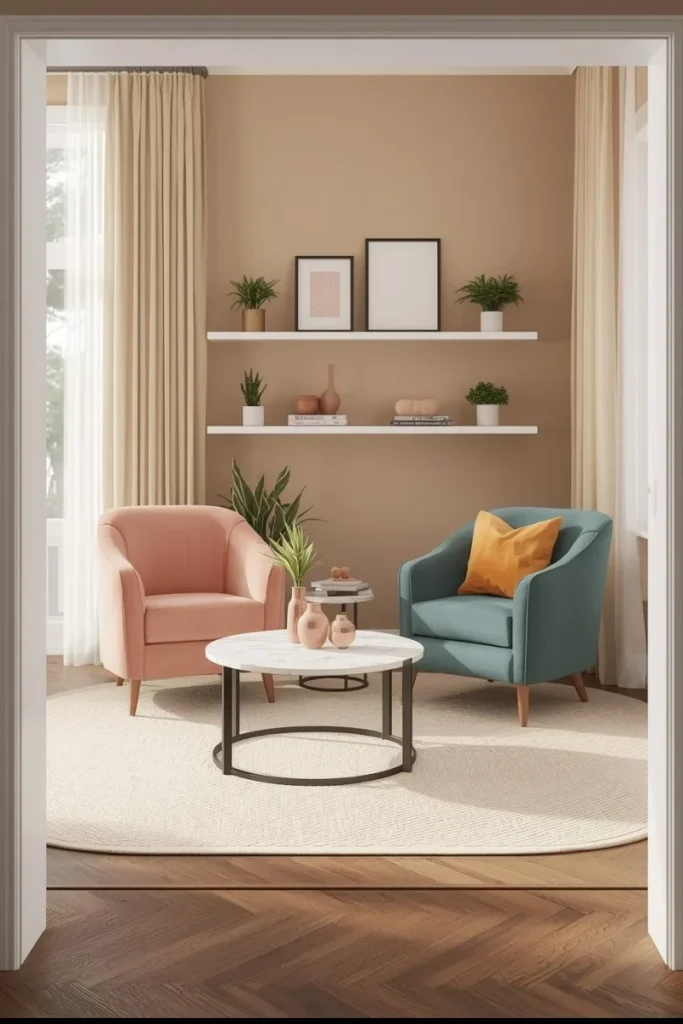
Accent chairs are a great way to add seating without committing to bulky furniture. Choosing compact, armless chairs or slipper chairs provides comfort while saving space. Their slim profiles make it easier to maneuver around the room, ensuring the layout stays open and airy. Positioned strategically, they can also enhance the flow of conversation by complementing the main sofa.
Functionally, accent chairs add versatility—you can easily move them to different areas of the room or use them as occasional seating when guests arrive. Upholstered in bold fabrics or interesting textures, they double as decorative features, adding a layer of personality to the room. Compact accent chairs strike a balance between style and practicality, making them a smart choice for small living rooms.
Final Thoughts
Designing a small living room may feel challenging at first, but with the right ideas, it can easily become the most stylish and comfortable corner of your home. The key lies in maximizing space without compromising on personality. By choosing light colors, multifunctional furniture, and clever storage solutions, a compact room can appear open and airy. Adding mirrors, layered lighting, and thoughtful layouts further enhances the sense of flow, turning limitations into opportunities for creativity.
Small living rooms also encourage intentional design—every piece matters. Instead of filling the room with unnecessary décor, focusing on a few impactful elements like statement lighting, bold rugs, or unique textures can make the space look curated and sophisticated. Comfort doesn’t have to be sacrificed for style; plush textiles, warm colors, and cozy seating can still shine in a smaller setting. The beauty of small spaces is their ability to feel intimate and inviting when designed with care.
Ultimately, the goal is to create a living room that reflects both functionality and personality. Whether you prefer modern minimalism, rustic charm, or eclectic warmth, these ideas show that even limited square footage can feel expansive with the right approach. A well-designed small living room is more than just a space to relax—it’s a reflection of creativity, resourcefulness, and the art of living beautifully within your means.




